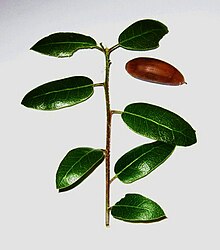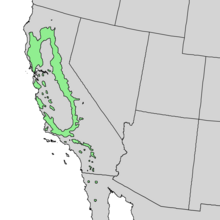| Interior live oak | |
|---|---|

| |
| Smooth leaves and acorn. The leaf margins are often spiny. | |

| |
| Typical growth habit | |
| Conservation status | |
 Least Concern (IUCN 3.1) | |
| Scientific classification | |
| Kingdom: | Plantae |
| Clade: | Tracheophytes |
| Clade: | Angiosperms |
| Clade: | Eudicots |
| Clade: | Rosids |
| Order: | Fagales |
| Family: | Fagaceae |
| Genus: | Quercus |
| Subgenus: | Quercus subg. Quercus |
| Section: | Quercus sect. Lobatae |
| Species: | Q. wislizeni |
| Binomial name | |
| Quercus wislizeni A.DC. | |

| |
| Combined ranges of Quercus wislizeni and Quercus parvula | |
| Synonyms | |
| |
Quercus wislizeni, known by the common name interior live oak, is an evergreen oak, highly variable and often shrubby, found in western North America.
Description
It is a large shrub or tree growing to 22 metres (72 feet) tall, although where it is common in the low-elevation Sierra Nevada foothills it seldom exceeds 10 m (33 ft). The dark-green leaves—appearing grayish from a distance—are usually small, 2–7 centimetres (1–3 inches) long, thick, and often spiny-toothed at higher elevations, particularly on young trees. The male flowers are on catkins, the female flowers in groups of 2–4 in leaf axils. The acorns are 1–2 cm (1⁄2–1 in) long, and mature the second season (about 18 months) after flowering.
Specimens can live for up to 200 years.
Taxonomy

Although originally published by Alphonse Pyramus de Candolle as "wislizeni", some sources mistakenly spelled the specific epithet "wislizenii". Correct spelling is with one "I", per ICN article 60C.2. Friedrich Adolph Wislizenus's specimen was thought by de Candolle to have been collected in Chihuahua, Mexico. German-born American botanist Georg Engelmann later corrected the location to the American fork of the Sacramento River near Auburn, California.
California physician and botanist (and one of the founding fathers of the California Academy of Sciences) Albert Kellogg described an oak in an 1855 publication as Quercus arcoglandis (spur acorn oak), apparently the same species as Q. wislizeni. This clearly predates French-Swiss botanist de Candolle's 1864 name, and if confirmed to be this same taxon would have priority.
Currently there are two recognized varieties of interior live oak:
- Q. wislizeni A. DC. var. wislizeni (1864)
- Q. wislizeni A. DC. var. frutescens Engelm (1878). This is an invalid taxon. Engelmann's Q. wislizeni var. frutescens description is virtually identical to de Candolle's Q. wislizeni, while Engelmann's Q. wislizeni description most closely matches Kellogg's Q. morehus.
Etymology
It was named for its collector, Friedrich Adolph Wislizenus (1810–1889).
Distribution and habitat
Q. wislizeni is found in many areas of California in the United States continuing south into northern Baja California in Mexico. It generally occurs in foothills, being most abundant in the lower elevations of the Sierra Nevada, but also widespread in the Pacific Coast Ranges—where since 1980 it has been known as a separate species Quercus parvula—and the San Gabriel Mountains.
Ecology
The interior live oak is a red oak (section Lobatae) in the California Floristic Province (series Agrifoliae). Q. wislizeni hybridizes with California black oak (Q. kelloggii) (= Quercus × morehus, Abram's oak). All California red oaks show evidence of introgression and/or hybridization with one another.
A common alliant tree is gray pine (Pinus sabiniana).
Deer browse the tree's foliage.
Uses
Humans use the wood as a fuel source. The acorns are edible.
References
- Jerome, D. (2017). "Quercus wislizeni". IUCN Red List of Threatened Species. 2017: e.T89254808A89254811. doi:10.2305/IUCN.UK.2017-2.RLTS.T89254808A89254811.en. Retrieved 11 November 2021.
- ^ de Candolle, Alphonse Pyramus (1864). Q. wislizeni (in Latin). Vol. 16. p. 67.
{{cite encyclopedia}}:|periodical=ignored (help) - "Quercus wislizeni A.DC". IPNI. Retrieved August 29, 2010. "Description of Q. wislizeni was published in Prodromus Systematis Naturalis Regni Vegetabilis ... (DC.) 16(2.1): 67 (1864)."
- ^ "Quercus wislizeni A.DC.". Tropicos. Missouri Botanical Garden. Retrieved August 9, 2010.
- ^ Flora of North America.
- ^ Turner, Mark; Kuhlmann, Ellen (2014). Trees & Shrubs of the Pacific Northwest (1st ed.). Portland, OR: Timber Press. p. 198. ISBN 978-1-60469-263-1.
- J. McMeill et al. (eds). 2012. International Code of Nomenclature for algae, fungi, and plants. Regnum Vegetabile 154. Koeltz Scientific Books. ISBN 978-3-87429-425-6
- Kellogg, Proc. Calif. Acad. 1(1):25 (1855)
- Jepson eFlora: Quercus wislizeni.
- Engelm., Trans. Acad. Sci. St. Louis 3:396 (1878).
- ^ Duncan A. Hauser; Al Keuter; John D. McVay; Andrew L. Hipp; Paul S. Manos (October 2017). "The evolution and diversification of the red oaks of the California Floristic Province (Quercus section Lobatae, series Agrifoliae)". Am. J. Bot. 104 (10): 1581–1595. doi:10.3732/ajb.1700291. PMID 29885216.
- "Quercus wislizeni". Calflora. Berkeley, California: The Calflora Database.
- Nixon, Kevin (1980). A Systematic Study of Quercus parvula Greene on Santa Cruz Island and Mainland California (Master's Thesis).
- Jepson eFlora: Quercus parvula.
- ^ Whitney, Stephen (1985). Western Forests. The Audubon Society Nature Guides. New York: Knopf. p. 382. ISBN 0-394-73127-1.
Bibliography
- Nixon, Kevin C. (1997). "Quercus wislizeni". In Flora of North America Editorial Committee (ed.). Flora of North America North of Mexico (FNA). Vol. 3. New York and Oxford: Oxford University Press – via eFloras.org, Missouri Botanical Garden, St. Louis, MO & Harvard University Herbaria, Cambridge, MA.
- Rosatti, Thomas J.; Tucker, John M. (2014). "Quercus parvula". In Jepson Flora Project (ed.). Jepson eFlora. The Jepson Herbarium, University of California, Berkeley.
- Rosatti, Thomas J.; Tucker, John M. (2014). "Quercus wislizeni". In Jepson Flora Project (ed.). Jepson eFlora. The Jepson Herbarium, University of California, Berkeley.
External links
| Taxon identifiers | |
|---|---|
| Quercus wislizeni |
|
- IUCN Red List least concern species
- Quercus
- Trees of Northern America
- Flora of California
- Natural history of the California chaparral and woodlands
- Natural history of the California Coast Ranges
- Natural history of the Peninsular Ranges
- Natural history of the San Francisco Bay Area
- Natural history of the Santa Monica Mountains
- Natural history of the Transverse Ranges
- Plants described in 1864
- Trees of Mediterranean climate
- Garden plants of North America
- Drought-tolerant trees
- Oaks of Mexico
